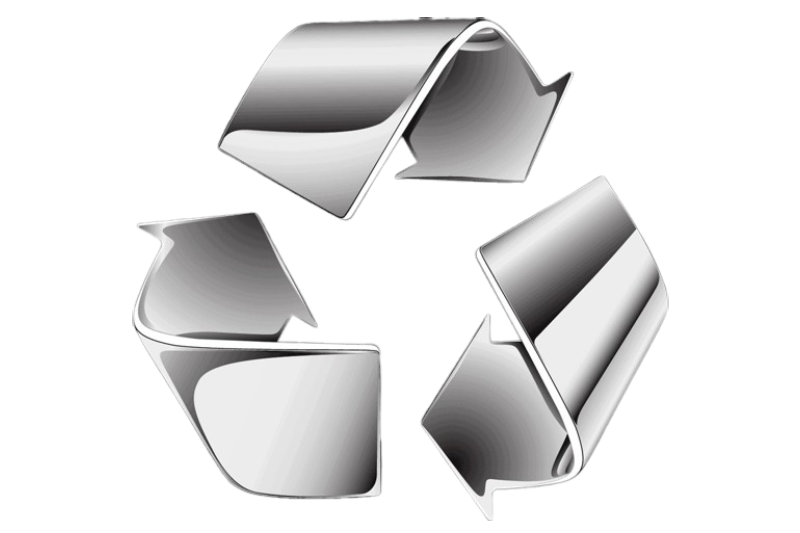Stainless Steel 100% recyclable?
Date : November 27, 2023The process of converting scraps stainless steel into new stainless steel is known as stainless steel recycling. Stainless steel is a highly recyclable material, with up to 80% of all stainless steel produced ever still in use today.
There are two main types of stainless-steel scrap:
- Reclaimed scrap (also known as old scrap)
- Industrial scrap (also known as new scrap)

Reclaimed scrap: This is scrap from stainless steel components that have reached the end of their useful life, such as unsuitable kitchen appliances, automobile components, and industrial equipment. Reclaimed scrap is made up of finished items such as chemical tanks, structural elements, or equipment, as well as demolition structural remains. It's already been used more often. Thus, the alternative term "old scrap."
Industrial scrap: This category includes trimmings and offcuts from the manufacturing process. Materials that remain and excess from fabrication, building, or manufacturing are known as industrial scrap. The excess sheet material, cut rods, and other by products of using stainless steel as a production material. It's not utilized; instead, its current state makes it useless. Therefore, the alternative name, new scrap.
However stainless steel can be recycled in any quantity, gathering it in stainless steel bins or storing scrap until you have enough for a recycling service to pick it up from is frequently the most affordable choice.
They will then take the scrap back to their facility and shred it, sorting the smaller pieces by makeup to generate new alloys or further processing the scrap for other purposes.
The scrap is collected initially and graded and type-sorted in order to recycle stainless steel. After that, it's cleaned and shredded into small pieces. After being shred, the scrap is melted in an electric furnace and mixed with additional raw materials to make new items made of stainless steel.
Recycling stainless steel offers a number of benefits, such as:
- It lowers greenhouse gas emissions and other air pollutants from the steel industry.
- It conserves natural resources, such as chromium and iron ore.
- Reusing stainless steel reduces energy consumption compared to producing it from raw sources.
- Less garbage ends up in landfills through this.
Stainless steel is a genuinely sustainable material since it can be recycled several times without losing its quality.
The following are a few instances of recyclable stainless-steel products:
- Kitchen utensils
- Appliances
- Automotive parts
- Industrial equipment
- Medical devices
- Construction material
- Architectural components
Advantages of Stainless-Steel Recycling
Stainless Steel Is Easy and Efficient to Recycle
One of the most straightforward metals to recycle is stainless steel. There is no metal lost during the recycling process because it is 100% recyclable. Moreover, its qualities do not degrade even after repeated recycling. Compared to other metals that lose some of their strength with each recycling process, this is a significant benefit. There's no need to worry about recycled stainless steel having less qualities than fresh steel as long as the material is certified.
Stainless Steel Recycling Provides Value
Stainless steel is still valuable enough to recycle even with its low value-to-weight ratio. Because stainless steel is used by many firms in such big numbers, they produce enough scrap to make an important profit. Additionally, as stainless steel is so versatile and in high demand, recyclers are constantly willing to buy scrap stainless steel.

Disadvantages of Stainless-Steel Recycling
Stainless Steel Recycling Value
Stainless steel is one of the less expensive industrial materials since it is a fairly common material with various applications in almost every industry. The combination of this with the density and weight of stainless-steel results in a low value-to-weight ratio for stainless steel scrap. Recycling stainless steel won't yield as much profit as recycling other metals.
Separating Stainless Steel for Recycling
Recycling stainless steel is an easy procedure, however separating different grades for recycling can be challenging because most varieties of stainless steel have a similar appearance. This is significant since there are grades of stainless steel that are much more expensive than others. It takes the use of technology like x-ray fluorescence (XRF) spectrometry to sort stainless steel.
Heat Distortion and Work Hardening
Work hardening can be achieved by any kind of cold working, including forming and machining, on austenitic stainless steels 304 and 316.
Metals deal with structural and dimensional changes in response to temperature fluctuations. Stainless steel is particularly extremely susceptible to the effects of heat due to its limited thermal conductivity and relatively high rate of thermal expansion. Reusing leftover stainless steel that has been processed might cause issues since machining and other procedures generate heat on the material's surface.


